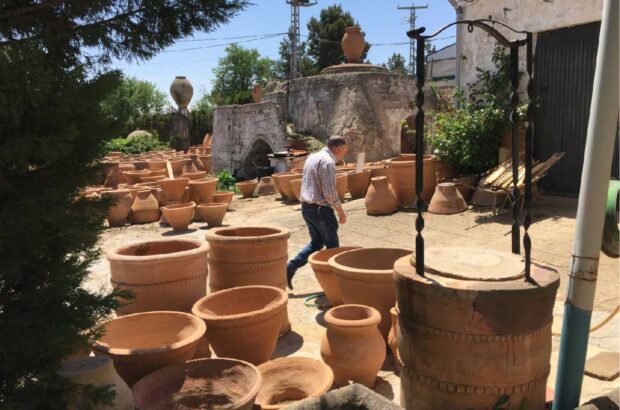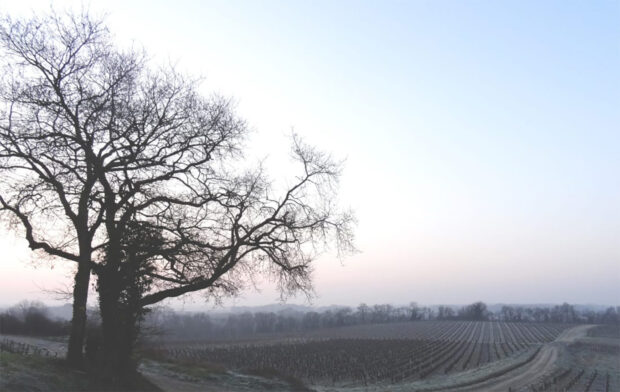In the United States the Rocky Mountains separate the country into a populous, humid eastern half and a mostly arid, sparsely settled west. Overall, the Rockies are America’s highest accumulation of land mass, but the absolute highest point in the US is not in the Rocky Mountains. It is Mount Whitney in the Sierra Nevadas, at 4,418m. The lowest point in North America (Death Valley, 61m below sea level) is also part of the Sierra Nevadas and the California wine district. The Sierras are a young range of mountains, geologically speaking, and perhaps they are confused. Indeed they’re still growing, a product of extraordinary tectonic pressure as the Pacific Plate subducts beneath the North American Plate.
The Sierras form a north-south wall along the eastern edge of California. They can be depicted as a trap-door hinged on the west: that is to say they rise gradually from the west and fall off precipitously on the east. The reason is that rain clouds come from the western side, so east of the Sierras, in their rain shadow, is a desert. Erosion is minimal on that side. The western side gets the precipitation, and the eroded material forms piedmonts, or alluvial fans, as the water runs out on the western side. These are the wine-growing districts officially recognised as the Sierra Foothills AVA (American Viticultural Area).Seventy-five percent of the precipitation that arrives in California comes in January and February, and much of it is cached in the Sierras as snow. When the snow melts in the spring and early summer, it flows west in a series of tumultuous rivers and, historically, these would pool in the great Central Valley, forming a marsh 80km across and 650km long. This water would then drain through the Delta into San Francisco Bay and eventually into the Pacific Ocean through the narrow gorge now spanned by the Golden Gate Bridge. The marsh was not permanent, however. Each year it would dry up by September/October, a magnificently fecund annual cycle that supported abundant populations of wildlife and Native Americans.
The history
The landscape has changed, though, and the changes have almost all been wrought in the last 151 years. California’s Gold Rush took place in 1849. The diggings were in the Sierra Foothills. Today the region retains much of that era’s flavour. Little towns dot a 325km long strip of west-facing slope from about 250m of elevation up to about 1,200m. Many have evocative names such as Ophir, Morman Bar, Dogtown, Copperopolis and Angels Camp. All have Victorian storefronts that line a single main street, usually with raised wooden sidewalks. Antique shops seem to be a mainstay of the modern economy. Bars like to call themselves saloons, and interior design tends heavily towards the Bordello school. The primary traffic artery north-south is appropriately named Highway 49. Well, the ’49’ part is appropriate; ‘highway’ is a bit of a stretch for a single lane in each direction that must descend and climb in and out of the multitude of canyons that carry water east to west out of the Sierras.Many of these canyons were transformed into steep-sided, V-shaped valleys in the period between 1850 and 1870. Placer mining was an incredibly efficient erosion technique. It uses much the same basic principle as hobbyist gold panners use today: river gravels are washed to remove silt, allowing what gold particles may exist to sink to the bottom of the container. A child with a pan in a stream may wash four or five kilos of gravel in a few hours. Two hard-working men with shovels and a rocker box might wash 1,500 kilos in a day. But one man with a placer cannon and a series of sluice boxes could wash thousands of kilos in the same time. The trick was to impound water several hundred feet above the cannon, then run it down through a four- to six-inch pipe to a one-inch nozzle. The force of the water stream thus generated could wash away entire hillsides in a few hours. Valleys hundreds of metres deep were actually created by human beings in the space of a few years. Placer mining was outlawed in 1870, but not before navigation in the Sacramento Delta had been completely destroyed. San Francisco Bay is over 15 kilometres across in some points, and 90 metres deep under the Golden Gate Bridge, where rapidly moving currents scour the bottom, but the Bay averages less than four metres deep overall. You can be on a yacht five kilometres from shore in the southern portion of San Francisco Bay and get stuck in silt hosed out of the mountains if you drift outside the dredged and marked channel.
The land
This massive transfer of soils from the Sierras to lower elevations in all likelihood plays an important role determining wine styles from the general area today. In the Delta, soils are peaty, loaded with organic matter and clay. East of the Delta in Lodi, soils are sandy down near Interstate Highway Five, but composed of large pebbles higher up near the Foothills. This distinction is only now being exploited for quality. In the past farmers chose the sandier soils because they were easier to work, or the peatier soils because they gave bigger crops. That various soil profiles give different results is clearly evident from the experience with Flame Tokay table grapes. In order to get the bright red colour that gave these grapes their name, they had to be grown on the alluvial fan from the Mokelumne River. That soil is called Hanford Loam. Grown anywhere else those grapes were merely ordinary. The phenomenon eventually died out in the market when seedless varieties became popular.
East of Lodi there are several districts around dammed rivers where soils look like those of the Southern Rhône, all shot through with rounded stones the size of a man’s fist. Farmers habitually avoided those, but grape growers are beginning to rethink the situation. As one climbs higher, the Sierra Foothills AVA begins. First one enters Amador County, where soils in all the road cuts have the dull orange/red colour of rust. Iron oxides begin forming as soon as the soil there is exposed to air. It is hard to dismiss as coincidental the fact that Amador wines have California’s most distinctive goût du terroir. Everything from Zinfandel to Sauvignon Blanc finishes with a signature flavour that reminds me of the aftertaste of spinach. It provides a backbone to the richly ebullient fruitiness of Amador Zins. Higher still, one enters El Dorado County, where most of the soil profiles are eroded basalt with more quartz-like compounds than nutrients and relatively thin depths.
The climate
In any event, the styles are very much elevation dependent. At high elevations the weather is cool, the season is shorter, there is more rain and less topsoil. Some snow will fall in the vineyards each winter. Wines from those districts have more acid, less alcohol, less body, and more delicate aromatics in the nose. These districts are also relative newcomers to the California viticultural scene. In many ways they are the frontier, because winemakers there are still learning to master these unique conditions. Anything below 240 metres is technically the Central Valley, not the Sierra Foothills. Lots of heat and deep, fertile soils produce large crops of intensely aromatic, softly structured, modestly priced, simply pleasurable wines. When made from old, dry farmed vines, which naturally limit crop loads, by artistically minded winemakers, these sites are capable of producing extremely impressive wines. Between 240 and 600m lies the historic band of Sierra Foothills wine growing. There, pockets of large-particled, infertile, three to six metre-deep but well-drained topsoils can be found. The weather is on the warm side of the spectrum, but nights are still cool. The wines are more dense, extractive and given to riper aromas than their uphill neighbours, but they have better complexity and backbone than the large crops produced closer to the floor of the Central Valley or in the Delta. Because of the Sierra Foothills’ history, several 75- to 120-year old, dry-farmed vineyards exist in this zone. Wineries which seek out grapes from those sites, and which cultivate long-term personal relationships with the often eccentric crones who own them, make wines that are among the best in North America today.
The wines and wineries
Touring the Sierra Foothills is more than a single-day trip. There are really five individual districts, and each is worthy of a separate day’s attention. Tremendous recreational opportunities attract millions of visitors to either end of the 320 kilometre-long Foothills region: Yosemite National Park in the south and Lake Tahoe in the north, with its skiing, gambling and summer boating. Nevertheless, the Foothills wine districts themselves are uncrowded, unpretentious and charming in a leisurely kind of way.
Calaveras
Calaveras County is best accessed by Highway Four out of Stockton (which, in turn, is reached by Highway 580 from the San Francisco Bay Area). The centrepiece of Calaveras, from a wine perspective, is the tiny hamlet called Murphys. It is about an hour north of Yosemite’s northern entrance. Three wineries recommend themselves to anyone staying in or around Murphys. Black Sheep is the smallest. It is in the town itself, and it does make the best Zinfandels. Stevenot is the oldest and is located in the most beautiful setting, a lovely valley 15 minutes north of town. Kautz-Ironstone is by far the largest winery in all of the Foothills, and it is the very definition of a ‘destination winery’. The mind boggles. It has a kitchen capable of feeding 1,500 people at once. It has a 20m high waterfall inside the winery, and a fireplace that must be nearly as big. The largest crystalline gold nugget ever found (it’s about three-quarters of a metre high) is on display in its souvenir shop. It owns a huge production facility in Lodi and thousands of hectares of grapes there, so the distinction between the Foothills and the Central Valley is somewhat vague in its wines. But, overall, the wines are well made and represent excellent bargains.If you’re looking for a good meal in this
district, seek out the Lickskillet Café in historic Columbia. Peg O’Hayer cooked for the US Olympic team in Nagano, Japan. Her eclectic 10-table establishment is decorated with many examples of a fascinating Native American technology: stone and metal axe heads turned into tools and weapons by allowing Madrone branches to grow securely into them for use as handles.
Amador
Amador County is the next wine district, north about 45 minutes along Highway 49. It can be reached directly by taking Highway 88 out of Stockton or Highway 16 out of Sacramento. Plymouth is the town centre of the wine-producing area, but there is not much by way of accommodation there. Better to stay and/or eat in nearby Jackson or Sutter Creek. The main AVA for Amador is called Shenandoah Valley. Fiddletown is a contiguous, slightly higher elevation AVA, but most of the grapes and wineries are in Shenandoah Valley. Barbera does well here, and Sangiovese and Syrah are showing excellent promise. But no matter how you slice it, the key to Amador is Zinfandel. Big, gutsy, hairy-chested Zinfandel. If ever there were an example of ass-whuppin’-in-a-bottle, this would be it. Amador Zins routinely go to 15% alcohol, but they have the intense fruit to carry it off. Moreover, the fruit is not some candy/berry/mama’s-boy dollop. It’s cassis with brass balls. Amador’s goût du terroir confers a complexity that has more to do with blast furnaces and leather harnesses than it does with any berries you’ve ever seen covered with cream in a bowl. Top practitioners include Renwood, Eastin (a speciality label from Domaine de la Terre Rouge winery), Youngs and Story. Montevina makes a good enough, honestly priced example that is widely available, along with its equally interesting new Italian varietals. Sobon Estate and Shenandoah Vineyards (same owner) are erratic, but brilliant on occasion. When considering almost any red wine from Amador, it is helpful to have a nodding acquaintance with pork ribs, slow cooked off to the side of hardwood coals and dry mopped with spices.
El Dorado
Eschewing Highway 49 for the moment, one can exit Shenandoah Valley to the east and enter El Dorado County by way of the somewhat remote, but wildly entertaining district called Fairplay. It is 20 minutes from Plymouth, and perhaps a half hour from Placerville, the governmental and accommodations seat of El Dorado County. Fairplay consists of seven wineries strung out along a circular road. Once there it is very convenient and great fun to do on bicycles. There are no restaurants, so picnic supplies are in order. The best place to stay overnight is Fitzpatrick’s chalet-style B&B, which features a laps pool and a ploughman’s lunch with bread baked from an outdoor oven. The most engaging social rendezvous would be the Charles Mitchell winery’s tasting room. It also has overnight rooms, a bocce ball court and a lovely pond for alfresco dining. Perry Creek is the largest winery in the district, and it sometimes seems a little too slick for this neighbourhood, but it has a wonderful winemaker. Nancy Steele makes idiosyncratic, beguiling Zinfandels that defy categorisation.
Moving on north and a little bit east, one comes to the winegrowing district surrounding Placerville itself. This is the high-elevation jewel in California’s crown. There are several vineyards at least 900 metres of altitude here. This is also the least well-recognised, top quality producing area in California. Placerville is on Highway 50, midway between Sacramento and the south shore of Lake Tahoe. It has been a small but stable city since the 1850s, when it was known as Hangtown. Four of the wineries ringing the city are well worth a look, although most travellers stop only for a bite to eat and automobile service in their mad rush to leave a lot of money at the Tahoe blackjack tables – a pastime made doubly poignant if done of an evening between heart-stopping days on the 900m vertical drop of Heavenly Valley’s magnificent ski slopes. Placerville’s pleasures are less extreme, but quite a bit more unusual.
Visit Sierra Vista winery, there to find Syrah made with the most sublime balance, the most wonderful insinuation of fruit intensity. Accomplished, as if by mirrors, without any trace of typical New World weight or fatness. These wines personify elegance and hint at what high-elevation viticulture in the Sierra Foothills may one day accomplish across a wide group of grape varieties. Next go to Madroña Vineyard. Dick Bush brought his young family up to the mountains in 1973. They planted their vineyard, then went to the Congo, where they taught maths in the Peace Corps for two years while their vines matured. Today the Bush kids run most of the show at the winery. Their Riesling is outstanding, and quite remarkable for its track record as an ageing candidate. A further example of high elevation potential, it always has high natural acidity, and actually requires about six years in the bottle to begin demonstrating its most fruitful period. The other two wineries you shouldn’t miss? Boeger, for the history and the Barbera, a reliable crowd-pleaser that has pepperoni pizza written all over it. And Lava Cap, for its Granite Hill Petite Sirah, a black-coloured wine that leaves you feeling like you’ve just had a really good massage with scented oils.
Nevada City
Highway 49 goes through Placerville, and if you get back on it for another hour and head north you will reach Nevada City. First you will go past a good white water rafting embarkation point on the American River, then past Coloma, where gold was first discovered in California. In Auburn, you will cross Highway 80, which is the major east-west thoroughfare from San Francisco to New York. I-80 goes past Squaw Valley and the north shore of Lake Tahoe, then on through Reno. Don’t be distracted, though. Your goal is the cultural capitol of the Sierra Foothills, the Queen of the Northern Mines. Nevada City is one of those places where everyone is very bright and well educated, but nobody is very intensively employed. In the vineyards, most of the picking is done by musicians. Nevada City’s theatre is the oldest continuously operating establishment of its type west of the Mississippi. Buildings on the main street have been restored. Art and music are the town’s lifelines, and two local wineries fit right into the picture. Indian Springs and Nevada City Winery both make broad ranges of very good wines, but especially noteworthy are their Cabernet Francs. These wines depart from normal Cab Franc fare by emphasising the high-toned perfume of violets in the middle of the wine. They aren’t light bodied, although the scent is certainly lifted and ethereal, providing yet another example of the unique characteristics conferred on so many Sierra Foothills wines by their position above the crowd.












